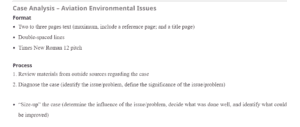Aviation Environmental Issues
Select a significant U.S. commercial airport that is considered to have noise issues. Assess the effectiveness of the airport in addressing its noise problem.
The Miami International Airport Noise Abatement Program
One of the primary environmental issues associated with establishing aviation is noise pollution. Airport authorities must find a balancing act between maximizing the airport’s airports and minimizing the negative environmental impacts caused by such establishments. Noise can have profound adverse effects on the physical, social well-being, psychological, quality of life, and health of humans (Sameh & Scavuzzi, 2016). Miami International Airport is one such airport that has been faced with numerous cases of noise pollution by the surrounding community. The Miami-Dade County Commission received a proposal to create an Aircraft Noise Abatement Advisory Board to help develop ways to reduce the impact of noise from aeroplanes on the neighbourhood. As such, working with ICAO and FAA, the board devised measures that have at least helped reduce the amount of noise that reaches the inhabitants of the locality surrounding the airport (Ortiz, 2008).
Are you seeking an authentic copy of the “Aviation” Environmental Issues essay”? Contac” us.
Over the years, the Miami-Dade Aviation Department has developed the procedures for noise control and operational guidelines implemented at the Miami International Airport. These have successfully abated airport and aircraft noise. Considering the MIA’s new arrival and departure procedures has been one such measure to lessen the noise exposure for the residential neighbourhoods. This includes moving the aircraft away from the runways and flying directly over points that minimize the overflight of residential areas. Moreover, flights in residential areas must fly at an altitude with considerably low noise reaching the residences. This is covered in the chartered visual approach procedures that require flights to fly higher over communities around the Miami International Airport when approaching landing.
At the airport, the MIA noise abatement authority necessitated the installation of an area in the airfield where all run-ups are carried. This area is surrounded by a state-of-the-art sound suppressant wall that reduces the sound of the engine maintenance operations at the airport. Run-up operations are also carried out during the day to lower disturbances to the residents in the neighbourhoods at night. A noise barrier was also constructed north of the airport, effectively reducing the noise to the residential areas within 500 feet of the wall by 10 decibels. This helped lower engine rolling, ground activity, taxing, and take-off noise.
The monitoring of noise emissions by the flights taking off and landing at the MIA is done by the Aircraft Noise and Operation Monitoring System, which helps in evaluating the effectiveness of the procures employed at the airport to reduce the impact of noise on the surrounding (Miami-Dade Aviation Department, 2015). These initiatives were developed through listening to the concerns of the surrounding neighbourhoods and have so far been critical in reducing the impact of noise arising from aircraft activities at the Miami International Airport. The sensitization of the airport operators on the need to adhere to the set standards on reduction of noise impact on the surrounding neighbourhood. This has also been carried out by the ‘Fly Neig’bourNeighbourly’, which has been running since 1995. This seeks to create awareness among the aviation employees at the MIA to be mindful of the community when in their duties (Miami-Dade Aviation Department, 2015).
Similar Post: Three critical ideas from Zinsser in “On Writing Well.”
References
Miami-Dade Aviation Department. (2015). Plane facts about aircraft noise. Miami-Dade: Miami International Airport.
Ortiz, L. (2008, May 29). Airport Noise Abatement Board On Its Way Back. Retrieved from Miami Today: https://www.miamitodaynews.com/news/080529/story5.shtm.l.
Sameh, M. M., & Scavuzzi, J. (2016). Environmental sustainability measures for air[orts. Occasional paper, McGill.
ORDER A PLAGIARISM-FREE PAPER HERE
We’ll wriWe’llerything from scratch
Question
Case Analysis – Aviation Environmental Issues
Format

Aviation Environmental Issues
- Two to three pages of text (maximum, include a reference page; and a title page)
- Double-spaced lines
- Times New Roman 12 pitch
Process
- Review materials from outside sources regarding the case
- Diagnose the case (identify the issue/problem, define the significance of the issue/problem)
- “Size-up” the cas” (determine the influence of the issue/problem, decide what was done well, and identify what could be improved)
- Provide recommendations (identify courses of action; what would you do differently?)
Develop a case analysis on this topic: Select a major U.S. commercial airport with noise issues. Assess the effectiveness of the airport in addressing its noise problem. As always, draw upon previous module knowledge to help you analyse.
Refer to the assignment guides and rubric in the activity and ensure your case analysis conforms to the assignment requirements. Use the rubric as a guide when completing this assignment. Remember to draw upon previous module knowledge to help you conduct your analysis.
To receive full credit, assignments must be submitted by the due date. You may lose points for late submissions—no submissions are accepted after the last day of the module/week. Collectively, case analyses are worth 40% of your course grade.
Your work will automatically be evaluated through the plagiarism detection tool upon submission. Ensure your work is entirely your own. Cite your sources!

